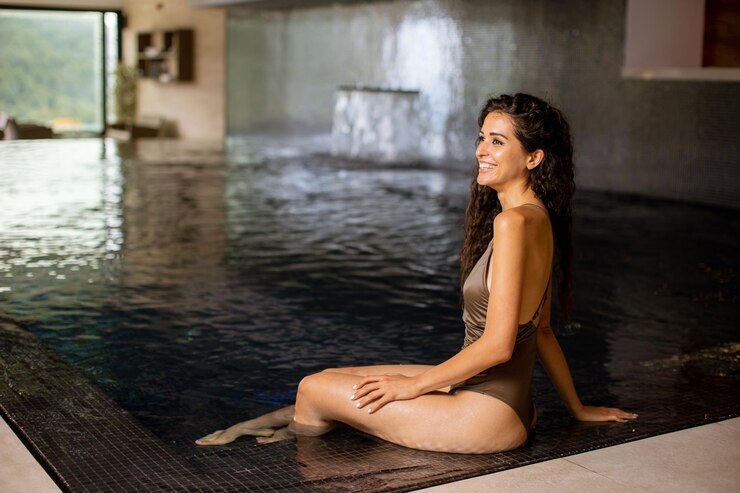Going for a swim with curly hair It’s safe to return to the water. Once you embrace your hair’s original texture, make sure you use a thick conditioner on your hair, whether it’s wet or dry, before you get in the water.
The conditioner prevents chlorine from penetrating curly hair’s pores, making it less susceptible to damage.
Every time you go swimming, you must wash your hair. Over time, chlorinated water can cause damage to the hair. Chlorine, on the other hand, strips hair of its natural oils. In addition, chlorine can penetrate the cuticle and damage the hair strands’ inner layers.
Chelating substances can be found in shampoos and conditioners that have little or poor suds. Because they remove chlorine and mineral deposits from hair. Other possibilities include shampoos for swimmers.
In this article, let’s find the answer: Why does chlorine make hair curly?
How Does Chlorine Make Hair Curly?
To keep the pool free of sludge and gunk, chlorine, a terrible trivalent compound composed of copper, iron, and manganese, is used.
Chemically permed or relaxed hair poses a greater risk to those of us with colored or relaxed hair due to the drying effect on the hair’s cuticle that occurs during these treatments.
A person’s particularly porous hair, such as thin or fine hair, is more vulnerable to damage from chlorine.
As a result, using a gentle pH-balanced curly hair shampoo that doesn’t contain silicones or oil is essential.
If chlorine wipes away all the moisture from your hair and scalp, wouldn’t a clarifying shampoo strip you’re already dried up, frizzy mane even more?
This is what some people believe, and it’s a common misconception. Let the shampoo stay on your hair for a few minutes after each wash, and then rinse thoroughly.
Your hair and scalp are thoroughly cleansed of chlorine in the first wash, and the strengthening elements of the shampoo can reach the hair in the second wash. Once your hair has been shampooed, make sure to thoroughly rinse it.
The Initiatives You Need to Take to Protect Your Hair from Chlorine
- Rinse Your Hair – This little yet crucial feature is frequently overlooked. Because our hair is already saturated with water, it will absorb less chlorine if we thoroughly rinse and saturate it before entering the pool. Once it has absorbed all of the water it can, a sponge simply runs out of water. A thorough pre-rinse will go a long way in making your hair look its best.
- Rinse Your Hair after Taking Shower – Keep in mind that your hair will not be “filthy” after you exit the water. Chlorine is added to pools because some people don’t need to wash their hair after swimming in chlorinated water, which is why chlorine is used. The finest “treatment” for your curls when you get out of the water is a lengthy, thorough shower. Using non-chlorinated water to drown out the chlorine in hair dilutes and eventually removes it. You can spend 10 minutes pondering the meaning of life while still accomplishing something.
- Follow Your Regular Hair Care Routine – After every swim, you should condition your hair with a leave-in conditioner. To restore the hair’s lost moisture, softness, and elasticity, conditioners can be applied to the hair. Your hair will be less prone to tangling if you coat it with an oil or serum.
- Try Styling – A loose bun, some twists or braids, and then letting your hair air dry is a great way to refresh your style. By doing this, you can keep your hair from being matted or knotted up while it dries. A diffuser-equipped hair dryer or a bonnet hair dryer can also be used to reduce the amount of heat you apply to your locks.
- Use Shampoo – If you begin to experience a swimmer’s hair, then Swimmers Shampoo is the right solution. Swimming shampoo not only removes chlorine and mineral deposits from natural hair but also removes swimmers’ green. You should use this shampoo if you have light-colored hair. The items I’ve included below are sulfate-free, hydrating, and can be used every day.
Does only water help to remove Chlorine?
Colored hair may become green if exposed to chlorine for a long period. You can remove chlorine with ease, however. You can use a chlorine-removal solution or a homemade remedy like apple cider vinegar or baking soda to get rid of it in the shower.
Summary
Before diving in, run cold water through your hair to remove the cause of the issue. Dry hair will absorb more chlorine than wet hair.
Using protective creams will help to keep your hair healthy in the end. Use a chlorine-fighting product to keep your hair safe from the damaging effects of swimming pool chemicals.
Adding water molecules to hair has something to do with it when wet, hair goes back to its original state, which is curly in your case.
